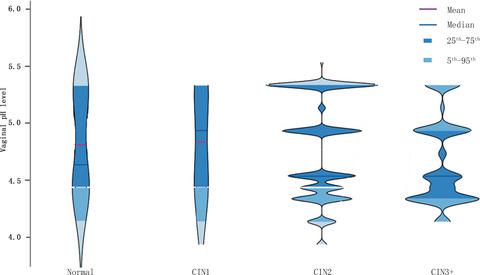当前位置:
X-MOL 学术
›
Cancer Med.
›
论文详情
Our official English website, www.x-mol.net, welcomes your
feedback! (Note: you will need to create a separate account there.)
A population-based study of age-related associations between vaginal pH and the development of cervical intraepithelial neoplasia.
Cancer Medicine ( IF 2.9 ) Pub Date : 2020-01-14 , DOI: 10.1002/cam4.2845 Peng Teng 1 , Min Hao 1
Cancer Medicine ( IF 2.9 ) Pub Date : 2020-01-14 , DOI: 10.1002/cam4.2845 Peng Teng 1 , Min Hao 1
Affiliation

|
The association between vaginal pH and the risk of cervical intraepithelial neoplasia (CIN) is unclear. We evaluated the dose-response relationship between vaginal pH and CIN risk, as well as the combined influence of vaginal pH and high-risk human papillomavirus (hrHPV) on the risk of CIN and the mediation effects of hrHPV infection on vaginal pH level and the development of CIN. We investigated 2304 women in Shanxi, China. The dose-response relationship between vaginal pH and CIN risk was assessed using categoric and spline analyses. We established interaction and mediation models to determine the correlation between pH and hrHPV in the development of CIN. After adjusting covariates, a positive association was observed between hrHPV infection and the development of CIN [OR (95% CI) = 4.75 (3.52-6.40) for CIN2+; OR (95% CI) = 7.30 (4.10-13.00) for CIN3+], while a negative correlation was showed between vaginal pH level and CIN3+ [OR (95% CI) = 1.04 (0.59-1.84); high vs low: OR (95% CI) = 0.32 (0.15-0.69), P = .002]. The highest risk of CIN (5.24 of CIN2+ and 5.80 of CIN3+) were observed when hrHPV infection was combined with middle vaginal pH (4.6-5.0). A significant mediation effect of hrHPV infection was observed in the association between vaginal pH level with CIN2+ (P = .002) and CIN3+ (P = .004). In conclusion, abnormal vaginal pH significantly induced the risk of high-stage CIN in Chinese women infected with hrHPV. Therefore, maintaining normal vaginal pH levels may reduce the risk of CIN.
更新日期:2020-01-14











































 京公网安备 11010802027423号
京公网安备 11010802027423号